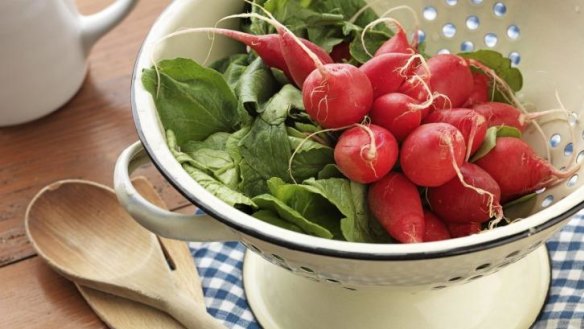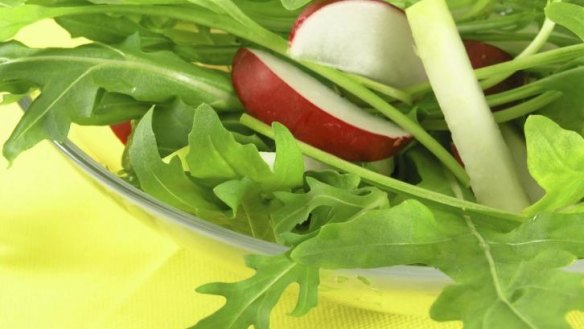Owen Pidgeon: Secrets of growing radishes all year in Canberra

Radishes are one of the few garden vegetables that you can grow the whole year round. The little plants will germinate and then withstand mild frosts. They are quick growers and are an easy vegetable to sow and to take care of.
Just make sure that you build up your garden bed to provide good drainage. Dig in plenty of compost and plant. Plant the seed between 5mm and 10mm deep, spacing them at around 4-5cm. Plant successive rows some 5cm apart, each fortnight. For a family of four, plant just 20 to 25 seeds each time, to provide a regular supply of juicy fresh radishes.
For me, radishes were mainly used as the ground-breaker for beetroot and carrots. They germinate in a few days, thus breaking up the surface of the soil for the slower-germinating root crops. Many varieties of radish can be harvested in three to four weeks. This is a vegetable that should be picked when young and tender. The radishes will normally keep well in the crisper section of the refrigerator for up to a week, especially when stored in one of the crisp and fresh plastic storage bags.

There is great diversity with radishes – so many shapes and sizes. Many of the smaller radishes are ready for harvest in three to four weeks. If you live in a unit or townhouse, then you can easily grow a small crop in terracotta or plastic pots. Place some little pebbles in the bottom of the container to provide drainage and then fill with a good quality potting mix that has a high humus content. Place in a sunny location and keep the soil moist, especially if growing in the warmer months.
The radish is considered to be a native of Asia but there are carvings in the pyramids that show it was cultivated more than 4500 years ago in Egypt. In ancient Greece at the temple of Delphi, there were symbols of vegetables made for the god Apollo, with those of the turnip made in lead, beets in silver and radishes in gold.
Cherry Belle is the deep red-coloured round radish with mild flavour. Early Scarlet Globe is another bright-red, quick-growing variety. Then you can grow the Pink Beauty, which has a rose-pink skin, still with a crisp, white flesh inside. Purple Plum offers a beautiful purple-skinned radish with quite a spicy flavour. Hailstone is the name of the pure white-skinned radish with a mild flavour.
Short cylindrical radishes include the delightful French Breakfast radish with a bright-red top with its white bottom tip. This radish is good to grow in cold climates and has been grown in home gardens since it was released in 1890. The French seed supplier Vilmorin also markets the small radish variety called 18 Days, one of the fastest to produce a crop for the kitchen. Another French variety is the D'Avignon radish which is also red and white in colour. This can grow to 10cm in length and it is a favourite for gardeners near the Mediterranean. If you want a mix of colours, then purchase a packet of the Easter Egg (or Fiesta Mix) radishes, which has a selection of small (4-5cm across) pink, red, purple and white, oval-shaped radishes.
The seeds of two fine radishes from China are now available here. The Watermelon radish is a large, round white radish which can grow up to 10cm in diameter in good soil. It has vivid pink flesh, which is quite sweet. It is very suitable for winter growing but takes seven to eight weeks to mature. The other Chinese radish is the cylindrical China Rose, which can grow to 15cm in length. It has a pale rose pink appearance. It will take two months to mature.
Asian friends seek out the giant Japanese daikon radishes at local Farmers' Markets. The Miyashige is a traditional stump-rooted radish which can grow up to 40 to 45cm in length. It can be grated, pickled or used in stir-fry dishes. Tokinashi is the other sought-after variety of daikon, from Fukuoka. It is quite pungent and commonly used for pickling. To grow daikon radishes, you will need a deep garden bed, hilled up and with lots of compost added in.
Radish and rocket salad
250g small radishes, quartered
750g Lebanese cucumbers, diced
250g Roma tomatoes, chopped
2 red spanish onions, thinly sliced
1 shallot, finely chopped
1 cup baby rocket leaves
salt and ground pepper
Dressing
¼ cup extra virgin olive oil
1 tsp mustard seed
3 tbsp lemon juice
1 tsp Dijon mustard
2 tsp castor sugar
Prepare the dressing by first heating the oil in a heavy-duty small saucepan and then adding in the mustard seeds. Cook until the mustard seeds begin to pop. Spoon the seeds into a medium-sized bowl and allow to cool. Add in the lemon juice, the Dijon mustard and the castor sugar and mix well.
Dice the radishes, cucumbers and tomatoes. Thinly slice the red onions and shallot. Mix together and add the rocket leaves. Add the dressing and mix well. Taste and season with salt and pepper. Add more lemon juice if desired.
This week in the garden
To get a crop of peas and broad beans, germinate this month. Plant in a sheltered location which receives plenty of sunshine. Plant at a depth of 5cm and allow more time than usual for germination.
When planting out onion seedlings, give the garden bed a good sprinkling of lime, as they do not like to be planted in acidic soils. Spread the roots out well and cover only lightly.
Plant out seedlings of spinach and silverbeet, also in beds that can be provided with some shelter as they become established.
Set up a frame around any small citrus trees and wrap with hessian to provide protection from heavy frosts.
Take time in the crisp, sunny days to keep up with winter pruning. Cut off old, dead brambleberry vines and raspberry canes down to near ground level. Trim off all the old strawberry leaves.
When you have a very cold or rainy day, take the time to review records of the crops you have grown and plan out your crop rotation program.
Owen Pidgeon runs the Loriendale Organic Orchard near Hall.
Restaurant reviews, news and the hottest openings served to your inbox.
Sign up